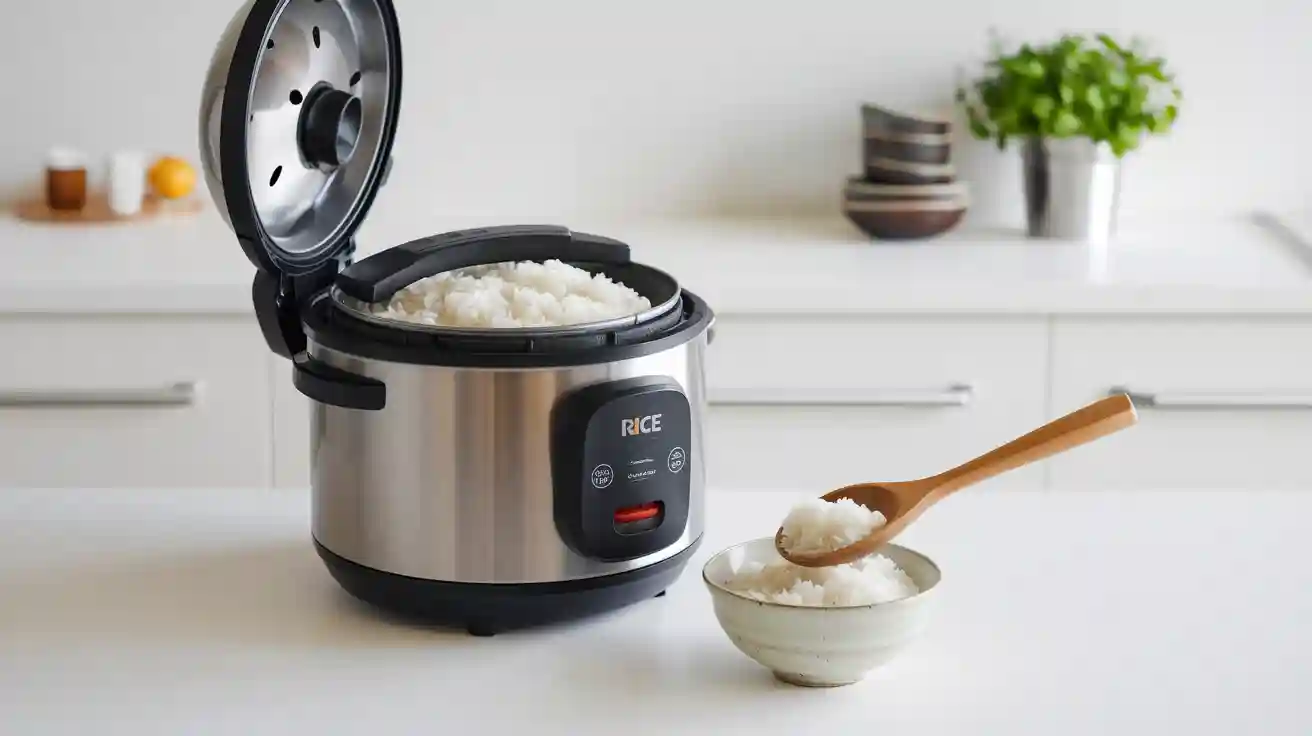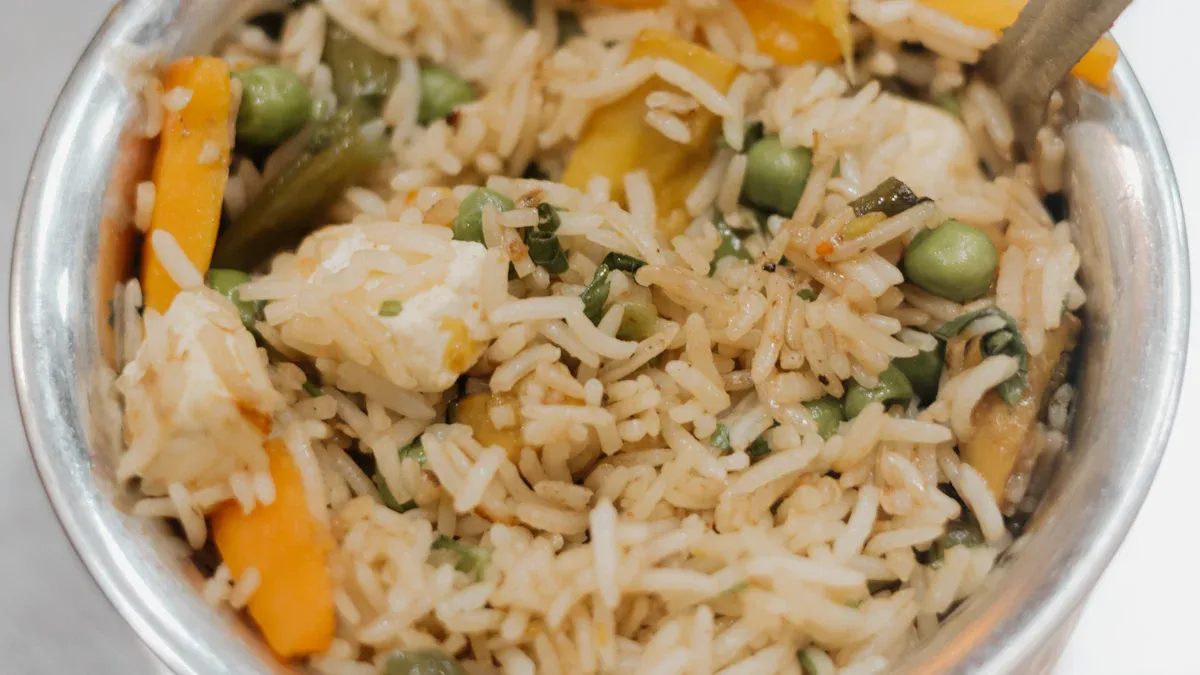
You get perfect rice every time with a rice cooker. Understanding how do rice cookers work helps you appreciate that smart cookers sense temperature and adjust heat, so you never have to worry about burning or undercooking. When cooking rice, you benefit from features like microchips that adjust time and temperature for each rice type, along with sensors and algorithms that deliver consistent results.
How Do Rice Cookers Work?
Rice cookers make cooking rice easy and reliable. You might wonder how do rice cookers work to deliver perfect results every time. The answer lies in their smart design and advanced technology. Let’s explore the main features that help you get fluffy, delicious rice with almost no effort.
Sensing Temperature Changes
When you start your automatic rice cooker, it begins by heating the water and rice together. The cooker uses built-in sensors to monitor the temperature inside the pot. As the water heats up, the temperature rises steadily. Once the water reaches its boiling point, the temperature stays the same until all the water is absorbed by the rice.
You benefit from these sensors because they can detect even small changes in temperature. Micom and digital cookers use microcomputers and fuzzy logic to control the cooking process. These technologies let your cooker adjust the time and heat based on the type and amount of rice you use. Technical reviews show that these features help the cooker sense when the rice is ready, so you get consistent results every time. Even though reviews do not give exact accuracy rates, you can trust that modern cookers use precise temperature detection.
Tip: You do not need to watch over your rice. The cooker’s sensors do the work for you!
Automatic Heat Adjustment
After the sensors detect the right temperature, the cooker automatically changes the heating level. This step is important because it prevents burning or undercooking. Your rice cooker can increase or decrease the heat as needed, depending on how much rice and water you use.
Testing shows that induction cookers reach an efficiency of over 85%. Some systems even average 90% efficiency, which means they use energy wisely while keeping your rice at the perfect temperature. Simulation studies also show that fuzzy logic controllers help the cooker track the right temperature for the right amount of time. This reduces the chance of overcooking or undercooking your rice.
Here’s a quick look at how automatic heat adjustment helps you:
- Keeps rice from sticking or burning
- Saves energy by using only as much power as needed
- Adjusts to different types and amounts of rice
| Performance Aspect | Numerical Result / Rating | Description / Context |
|---|---|---|
| Induction Cooker Efficiency | 85.56% – 90.10% | High efficiency in heating and automatic power adjustment |
| Fuzzy Logic Temperature Control | Superior tracking | Maintains correct temperature for perfect rice |
| Energy Savings | 12 to 15 units/month | Improved warming mode keeps rice fresh longer |
| Warming Duration | 5 to 7 days | Rice stays warm and fresh for several days |
| Electricity Consumption (300W) | 0.3 kWh/200g rice | Lower wattage cookers use less electricity |
| Electricity Consumption (1000W) | 1.0 kWh/200g rice | Higher wattage cookers use more electricity |
The Role of the Inner Pot
The inner pot is a key part of how rice cookers work. You place your rice and water inside this pot. The material and design of the inner pot help spread heat evenly. This even heating makes sure every grain of rice cooks the same way.
Most inner pots have a non-stick coating. This makes cleaning easy and helps prevent rice from sticking or burning. Some high-end cookers use thick, multi-layered pots to improve heat distribution. You get better results because the pot keeps the temperature steady during cooking.
Note: Always use the right amount of water and rice for your cooker. The inner pot often has measurement lines to help you.
When you use a rice cooker, you rely on smart sensors, automatic heating, and a well-designed inner pot. These features work together to answer the question: how do rice cookers work so well? You get perfect rice with little effort, every single time.
The Science of How Rice Cookers Work
Water Absorption and Starch Gelatinization
When you cook rice, water moves into each grain. This process is called water absorption. As the rice heats up, the starch inside the grains starts to change. Scientists call this change starch gelatinization. Studies show that water absorption and gelatinization depend on both temperature and how much water is present. For example, researchers found that the activation energy for these changes ranges from 18.5 to 24.7 kcal g-mole−1 between 50°C and 85°C. When the temperature rises above 60°C, the rice grains swell, and the starch transforms. This transformation gives you soft, fluffy rice. Scientists also use models to predict how much water the rice will absorb and how much the starch will change. These models help explain why you get perfect rice with an automatic rice cooker.
The Boiling Point Trigger
You might wonder how do rice cookers work to know when your rice is ready. The answer lies in the boiling point trigger. When the water in the pot reaches about 100°C, the rice cooker senses this temperature. At this point, most of the water has been absorbed or evaporated. The cooker then knows it is time to finish cooking. Laboratory experiments measured these temperature thresholds in different heating modes. The table below shows the results:
| Heating Mode | Central Temp (CL, CU) | Maintenance Temp | Notes |
|---|---|---|---|
| Mode 1 | 100°C | 100°C | Fastest heating, steady high temp |
| Mode 2 | ~100°C | ~95°C | Slightly lower at some points |
| Mode 3 | <100°C | Drops at CU | Less steady, more heat dissipation |
Automatic Shutoff Mechanism
Once the rice cooker senses that the temperature has reached the boiling point and most water is gone, it activates the automatic shutoff mechanism. This feature stops the cooking process at just the right time. You do not need to guess or check the rice. The cooker does it for you. This is a key part of how do rice cookers work so well. You always get rice that is cooked through, not burnt or soggy. The automatic rice cooker uses this science to make sure you enjoy perfect rice every time.
Advanced Technologies for Perfect Rice

Induction Heating
You can find induction heating rice cookers in many modern kitchens. These cookers use a magnetic field to heat the entire inner pot directly. This method gives you precise control over the temperature. The heat spreads evenly, so every grain of rice cooks the same way. Induction heating responds quickly to changes, which helps prevent burning or undercooking. You get fluffy rice with less effort because the cooker adjusts the heating level in real time.
Microcomputer (Micom) Controls
Micom controls bring smart technology to your rice cooker. A microcomputer inside the cooker reads data from sensors and makes decisions during cooking. You do not need to guess when your rice is ready. The Micom system changes the heating time and temperature based on the type of rice and the amount of water. This feature helps cookers handle different recipes, such as brown rice or sushi rice, with ease. You get consistent results every time.
Fuzzy Logic Technology
Fuzzy logic technology takes rice cooking to the next level. This system lets your cooker “think” like a human. It makes small changes to heating and timing for the best texture. Researchers have tested fuzzy logic by predicting rice texture, such as hardness and stickiness, using advanced modeling and instrumental methods. The table below shows how this technology works in practice:
| Aspect Evaluated | Description | Outcome/Implication |
|---|---|---|
| Modeling Techniques | Fuzzy Logic, Neural Networks, Regression | Predicts rice texture attributes from instrumental data |
| Instrumental Methods | Spectral Stress-Strain Analysis, NIR Spectroscopy | Accurate predictions of rice texture, similar to traditional methods |
| Sensory Attributes | Hardness, Stickiness, Cohesiveness, Roughness, Toothpull, Toothpack | High correlation between data and sensory evaluation |
| Impact | Helps optimize rice texture and maximize consumer satisfaction | Fuzzy logic is a promising tool for perfect rice |
You benefit from this technology because it helps cookers deliver rice with the ideal texture, even as researchers continue to improve these systems.
User-Friendly Features That Ensure Consistency
Multiple Cooking Modes
You can choose from several cooking modes on most modern rice cookers. These modes let you cook different types of rice, such as white, brown, or sushi rice. Some cookers even offer settings for porridge or quick-cook options. When you select the right mode, the cooker adjusts the time and temperature for that specific rice type. This feature helps you get the best texture and taste every time.
Tip: Always check your rice cooker’s manual for the best mode for your favorite rice.
Keep-Warm and Timer Functions
You do not have to worry about cold or overcooked rice. The keep-warm function keeps your rice at the perfect serving temperature for hours. You can set the timer so your rice finishes cooking exactly when you want it. This means you can come home to fresh, hot rice without waiting.
- Keep-warm: Maintains rice temperature after cooking.
- Timer: Lets you schedule cooking in advance.
| Feature | Benefit |
|---|---|
| Keep-Warm | Fresh rice for hours |
| Timer | Ready rice when you need it |
Easy Cleaning and Maintenance
You save time with easy-to-clean rice cookers. Most inner pots have a non-stick coating, so rice does not stick. Many parts are removable and dishwasher-safe. You can wipe the outside with a damp cloth. Regular cleaning keeps your cooker working well and your rice tasting great.
Note: Clean your rice cooker after each use to keep it in top shape!
Why Rice Cookers Outperform Manual Cooking
Eliminating Guesswork
You do not need to guess when you use a rice cooker. Many people find that even a $40 rice cooker can make rice as well as expensive models. You just add rice and water, press a button, and wait. The cooker handles the heat and timing for you. Stovetop methods need you to watch the pot and adjust the heat. If you miss the right moment, your rice can burn or stay hard. With a rice cooker, you avoid these problems. The machine automates the process, so you get good rice every time without stress.
Consistency and Reliability
You want rice that tastes the same every time. Rice cookers use advanced heating modes to make this possible.
- Induction heating spreads warmth evenly, so every grain cooks the same way.
- Some brands, like Zojirushi and Cuckoo, use special technology to keep rice at the right temperature for hours.
- Regular cleaning and checking the parts help your cooker work well for years.
- Models from Aroma Housewares and Panasonic are built for heavy use and keep rice quality high.
- Good insulation and nonstick pots, like those from Hamilton Beach, help prevent burning and drying out.
When you choose a reliable brand and care for your cooker, you get steady results and less wasted food.
Time and Effort Savings
You save time and energy with a rice cooker. You do not need to stand by the stove or stir the pot. You can do other things while the rice cooks. The keep-warm setting lets you eat when you are ready. Cleaning is easy because most pots have a nonstick surface. You spend less time cooking and cleaning, so you have more time for what matters to you.
You get perfect rice every time with a rice cooker. Smart automation and precise temperature control make cooking easy.
- Cooking time drops by 25%
- Energy use improves by 15%
- Burnt rice falls below 1%
Consumer Reports found rice cookers always deliver soft, fluffy grains with better taste and texture than stovetop methods.
FAQ
How much water should you use in a rice cooker?
You should follow the measurement lines inside the inner pot. For most white rice, use a 1:1 ratio of rice to water.
Tip: Always check your rice cooker’s manual for best results.
Can you cook other grains in a rice cooker?
Yes, you can cook grains like quinoa, barley, or oats. Select the right mode or adjust the water amount for each grain.
- Try using the “multigrain” or “porridge” setting if available.
Why does rice sometimes stick to the bottom?
Rice may stick if you use too little water or do not rinse the rice. A nonstick inner pot helps prevent sticking.
Rinse your rice before cooking for fluffier, non-sticky results.


